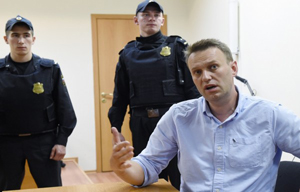Moscow, Jun 13: Russian opposition leader Alexey Navalny was found guilty of repeatedly calling for unlawful protests and sentenced to 30 days of detention, following a day of nationwide anti-corruption demonstrations, the media reported.
Navalny, in court in Moscow, on Monday night accused the judge of helping the police write the justification for his arrest, reports CNN.
His wife, Yulia, reported Navalny was detained at his Moscow home.
"30 days", Navalny tweeted after the sentencing. "Not only they robbed the whole country, but I'll miss Depeche Mode (British rock band) concert in Moscow because of them."
The opposition leader, who plans to run against Vladimir Putin in next year's presidential election, had mobilised support on social media platforms for the protests.
The arrest of Navalny came as thousands of protesters clashed with police in Moscow and St. Petersburg earlier on Monday, reports CNN.
Nearly 1,400 people were arrested in Moscow and St. Petersburg, according to OVD, an independent group monitoring arrests.
The group said 825 people were detained during protests in the capital and 548 arrested in St. Petersburg.
Russian authorities warned the public and declared the planned rally in the capital was illegal.
White House Press Secretary Sean Spicer condemned the arrests and called on Russia "to release all peaceful protesters".
"The United States strongly condemns the detention of hundreds of peaceful protesters throughout Russia," Spicer said, calling it "an affront to core democratic values".





Comments
Add new comment